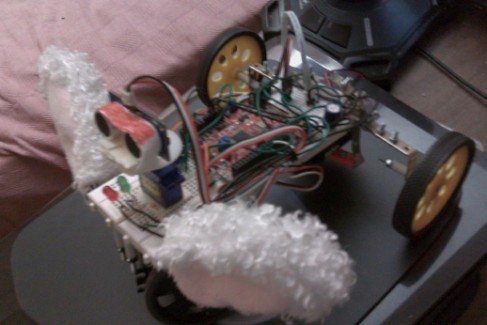3 Wheeler using 2 servos.
This is an idea I wanted to try for a while. Basically, it uses one servo to drive the main wheel and a connected (90 degree) servo to turn that servo for steering. The concept of my "big wheel" "trike" works quite nicely. I am using a Digilant uC32 in "pure" Arduino C/C++ code mode to control the bot. Of all the ways to program a robot, this still remains one of the easiest. Special features include a pot on an analog input to control the PING))) ultrasonic rangefinder "trigger" distance. At that point the robot looks around and finds another route. There is also code to help the robot get out of situations in which it gets "trapped" between objects. It works most of the time and the robot seldom gets itself "stuck". Metal parts and other items? From other kits (some of which look like they came right out of an "Erector Set"! :-) (Screws, nuts, paper tape, and double-sided foam tape hold the entire bot together.) It only took a day and was definitely a "fun build".
An interesting 3 wheel bot.
- Actuators / output devices: 2 servos (one continuous rotation and one standard)
- Control method: autonomous
- CPU: Digilant uC32 (Arduino compatible)
- Operating system: MPIDE
- Power source: 6 Rechargeable AA cells
- Programming language: C/C++
- Sensors / input devices: PING))) sonar
- Target environment: indoor flat surfaces


